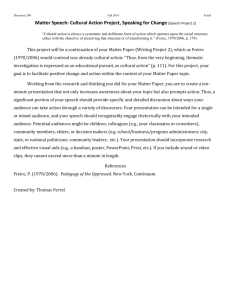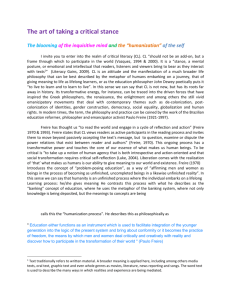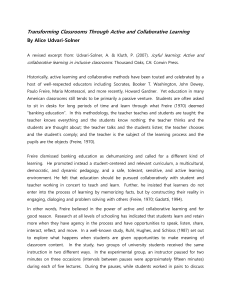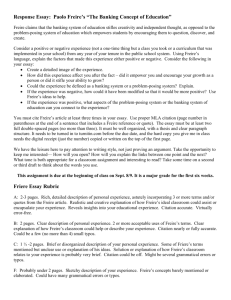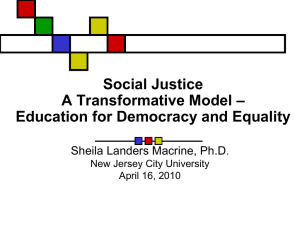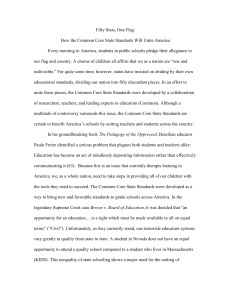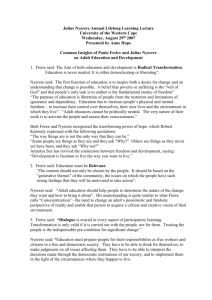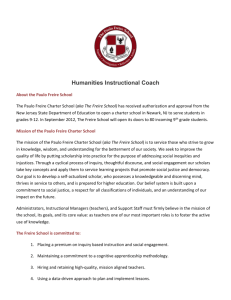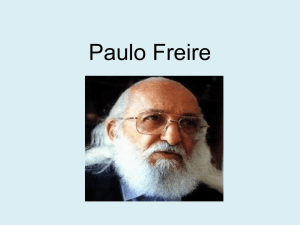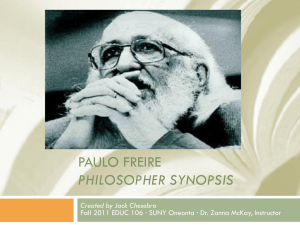(con)text method
advertisement
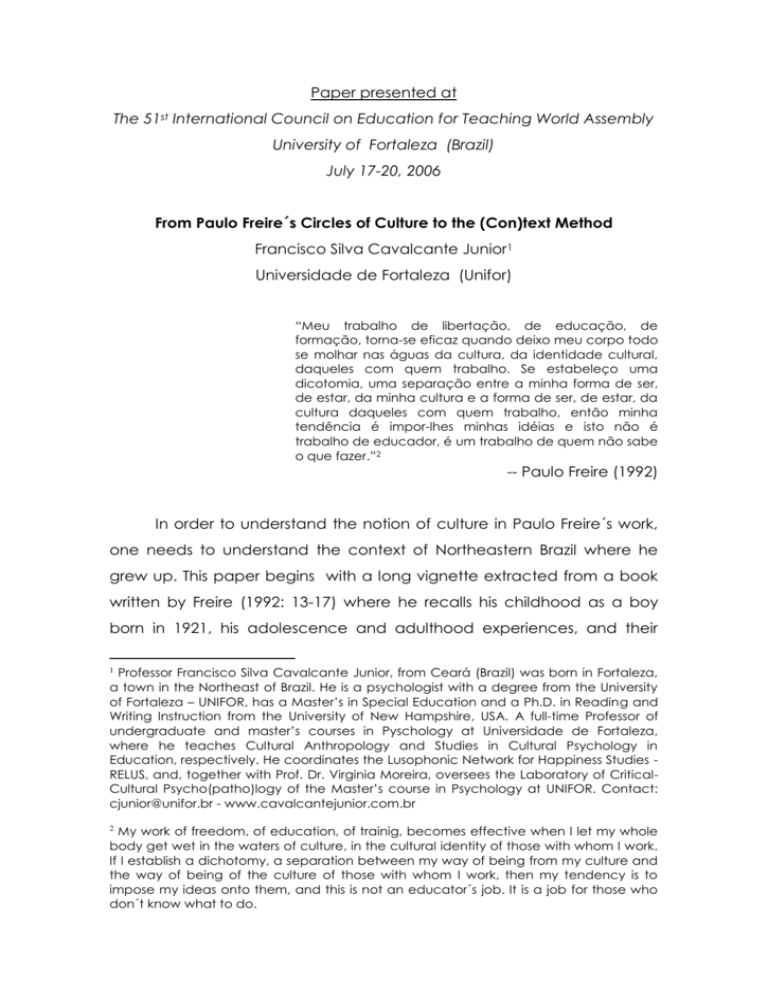
Paper presented at The 51st International Council on Education for Teaching World Assembly University of Fortaleza (Brazil) July 17-20, 2006 From Paulo Freire´s Circles of Culture to the (Con)text Method Francisco Silva Cavalcante Junior1 Universidade de Fortaleza (Unifor) “Meu trabalho de libertação, de educação, de formação, torna-se eficaz quando deixo meu corpo todo se molhar nas águas da cultura, da identidade cultural, daqueles com quem trabalho. Se estabeleço uma dicotomia, uma separação entre a minha forma de ser, de estar, da minha cultura e a forma de ser, de estar, da cultura daqueles com quem trabalho, então minha tendência é impor-lhes minhas idéias e isto não é trabalho de educador, é um trabalho de quem não sabe o que fazer.”2 -- Paulo Freire (1992) In order to understand the notion of culture in Paulo Freire´s work, one needs to understand the context of Northeastern Brazil where he grew up. This paper begins with a long vignette extracted from a book written by Freire (1992: 13-17) where he recalls his childhood as a boy born in 1921, his adolescence and adulthood experiences, and their Professor Francisco Silva Cavalcante Junior, from Ceará (Brazil) was born in Fortaleza, a town in the Northeast of Brazil. He is a psychologist with a degree from the University of Fortaleza – UNIFOR, has a Master’s in Special Education and a Ph.D. in Reading and Writing Instruction from the University of New Hampshire, USA. A full-time Professor of undergraduate and master’s courses in Pyschology at Universidade de Fortaleza, where he teaches Cultural Anthropology and Studies in Cultural Psychology in Education, respectively. He coordinates the Lusophonic Network for Happiness Studies RELUS, and, together with Prof. Dr. Virginia Moreira, oversees the Laboratory of CriticalCultural Psycho(patho)logy of the Master’s course in Psychology at UNIFOR. Contact: cjunior@unifor.br - www.cavalcantejunior.com.br 1 My work of freedom, of education, of trainig, becomes effective when I let my whole body get wet in the waters of culture, in the cultural identity of those with whom I work. If I establish a dichotomy, a separation between my way of being from my culture and the way of being of the culture of those with whom I work, then my tendency is to impose my ideas onto them, and this is not an educator´s job. It is a job for those who don´t know what to do. 2 2 impact on who he became and what he did throughout his life that led him to create the Paulo Freire´s method: I see myself in the average house in Recife, Brazil, where I was born, encircled by trees. Some of the trees were like persons to me, such was the intimacy between us. In their shadow I played, and in those branches low enough for me to reach I experienced the small risks that prepared me for greater risks and adventures. The old house – its bedrooms, hall, attic, terrace (the setting for my mother´s ferns), backyard – all this was my first world. In this world I crawled, gurgled, first stood up, took my first steps, said my first words. Truly, that special world presented itself to me as the arena of my perceptual activity and therefore as the world of my first reading. The texts, the words, and the letters of that context were incarnated in a series of things, objects, and signs. In perceiving these I experienced myslef, and the more I experienced myself, the more my perceptual capacity increased. I learned to understand things, objects, and signs through using them in relationship to my older brothers and sisters and my parents. The texts, words, letters of that context were incarnated in the song of the birds – tanager, flycatcher, thrush – in the dance of the boughs blown by the strong winds announcing storms; in the thunder and lightening; in the rainwaters playing with geography, creating lakes, islands, rivers, streams. The texts, words, letters of that context were incarnated as well in the whistle of the wind, the clouds in the sky, the sky´s color, its movement; in the color of foliage, the scape of leaves, the fragrance of lowers (roses, jasmine); in the trunks; in fruit rinds, the varying color tones of the same fruit at different times – the green of a mango when the fruit is first forming, the green of a mango fully formed, the greenishyellow of the same mango ripening, the black spots of an overripe mango – the relationship among these colors, the developing fruit, its resistance to our manipulation, and its taste. [...] Animals were equally part of that context – the same way the family cats rubbed themselves againt our legs, their mewing of entreaty or anger; the ill humor of Joli, my father´s old black dog, when one of the cats came too near where he was eating what was his. In such instances, Joli´s mood was completly different from when he rather playfully chased, caught, and killed one of the 3 many opossums responsible for the disappearance of my grandmother’s fat chickens. Part of the context of my immediate world was also the language universe of my elders, expressing their beliefs, tastes, fears, and values which linked my world to a wider one whose existence I could not even suspect. In the effort to recapture distant childhood, to understand my act of reading the particular world in which I moved, I re-created, relived the experiences I lived at a time when I did not yet read words. [...] My parents introduced me to reading the word at a certain moment in this rich experience of understanding my immediate world. Deciphering the word flowed naturally from reading my particular world; it was not something superimposed on it. I learned to read and write on the ground of the backyard of my house, in the shade of the mango trees, with words from my world rather than from a wider world of my parents. The earth was my blackboard, the sticks my chalk. When I arrived at Eunice’s Vasconcelos’ private school, I was already literate. [...] With her [Eunice], reading the word, the phrase, and the sentence never entailed a break with reading the world. With her, reading the word meant reading the word-world. [...] Continuing the effort of rereading fundamental moments of my childhood experience, of adolescence and young manhood – moments in which a critical understanding of the importance of the act of reading took shape in practice – I would like to go back to a time when I was a secondary school student. There I gained experience in the critical interpretation of texts I read in class with the Portuguese teachers´s help, which I remember to this day. [...] Sometime afterward, as a Portuguese teacher in my twenties, I experienced intensely the importance of the act of reading and writing – basically inseparable – with first-year high school students. I never reduced syntactical rules to diagrams for students to swallow, even rules governing prepositions after specific verbs, agreement of gender and number, contractions. On the contrary, all this was proposed to the students’ curiosity in a dynamic and living way, as objects to be discovered within the body of texts, whether the students’ 4 own or those established writers, and not as something stagnant whose ouline I described. I always saw teaching adults to read and write as a political act, an act of knowledge, and therefore a creative act. I would find it impossible to be engaged in a work of mechanically memorizing vowel sounds [...]. Nor could I reduce learning to read and write merely to learning words, syllables, or letters, a process of teaching in which the teacher fills the supposedly empty heads of learners with his or her words. On the contrary, the student is the subject of the process of learning to read and write as an act of knowing and of creating. [...] Reading the world always precedes the word, and reading the word implies continually reading the world. As I suggested earlier, this movement from the word to the world is always present; even the spoken word flows from our reading of the world. In a way, however, we can go further and say that reading the word is not preceded merely by reading the world, but by a certain form of writing it or rewriting it, that is, of transforming it by means of conscious, practical work. I believe that these snippets of Paulo Freire´s autobiography are needed for people elsewhere to be introduced to the context where his ideas emerged and, in many ways, still is the context where we, the Brazilians from Northeastern Brazil, live nowadays. In order to present an overview of Freire´s lived experiences that prompted him to create later in his career the Adult Education Program of the Popular Culture Movement which became known around the world as the Paulo Freire Method in the circles of culture, I continue to present below some highlights of his life which became sources of his theoretical reflections, as told by him in a number of his publications. In 1947, during his last year of law school, Paulo Freire, while teaching Portuguese at the same school where he completed his secondary education, was invited by a good friend of his to join the Division of Education and Culture of the SESI (Industrial Social Service) in Pernambuco. His field experience, during almost a decade of work in the 5 education of young adults and adults within this institution– a “foundational time” in his life as he recalls – became essential for the development of his first book, an edited version of a Ph.D. dissertation defended at the University of Recife in 1965, published in 1967 as Educação como prática da liberdade [Education as an act of freedom] (Freire, 1967). That book became the forerunner of his next book, Pedagogia do Oprimido [Pedagogy of the oppressed] which was orginally written in Portuguese with a first edition published in English in 1970, and its first printing in Brazil was only possible in 1975 (due to this country´s political realities following the military coup in 1964). The political realities before 1964 supported Freire´s emerging ideas. His work at SESI consisted of the study of and interventions in the relationship between the school and families. As part of his activities he conducted research with the families of 1,000 students. He wished to understand the type of relationships parents had with their daughters and sons, focusing on the aspect of punishments and rewards. After collecting all the data and having analyzed it, he scheduled a series of visits to SESI nuclei and social centers in the state of Pernambuco to share, with the parents and teachers, the results from his inquiry. At that time he used to give long talks on themes he chose previously for presentation “repeating the traditional route of discourse about something that you would give an audience” (Freire, 1994: 22). After one of his ordinary presentations when he talked about the theory of Piaget to parents who lived in poor, rural areas of Pernambuco, a parent in his forties raised his hand to speak. The long dialogue is transcribed below due to its importance as a struggle in Freire’s career, moving from being a traditional educator to being a progressive one, and because of the important cultural description it presents about the population living in poverty in Northeast Brazil (Freire, 1994, 22-23): “We have just heard,” he began, “some nice words from Dr. Paulo Freire. Fine words, in fact. Well spoken. Some of them were even simple enough for people 6 to understand easily. Others were more complicated. But I think I understood the most important things that all the words together say. Now I’d like to ask the doctor a couple of things that I think my fellow workers will agree on with me.” He held me in a mild, but penetrating gaze, and asked: “Dr. Paulo, sir – do you know where these people live? Have you ever been in any of our houses, sir?” And he began to describe their pitiful houses. He told me of the lack of facilities, of the extremely minimal space in which all their bodies were jammed. He spoke of the lack of resources of the most basic necessities. He spoke of physical exhaustion, and of the impossibility of dreams for a better tomorrow. He told me of the prohibition to be happy – or even of having hope which was imposed on them. [...] He paused a few seconds, looking over the entire audience, then stared at me once more, and said, “Doctor, I have never been to your house. But I’d like to describe it for you, sir. How many children do you have? Boys or girls?” “Five,” I said – scrunching further down into my chair. “Three girls and two boys.” “Well, Doctor, your house must be the only house on the lot, what they call an oitão livre house,” a house with a yard. “There must be a room just for you and your wife, sir. Another big room, that’s for the three girls. There’s another kind of doctor, who has a room for every son and daughter. But you’re not that kind – no, sir. You have another room for the two boys. A bathroom with running water. A kitchen with Arno [name brand] appliances. A maid’s room – much smaller than your kid’s rooms – on the outside of the house. A little garden, with an ‘ingress’ (the English word) lawn,” a front lawn. “You must also have a room where you toss your books, sir – a ‘study’, a library. I can tell by the way you talk that you’ve done a lot of reading, sir, and you’ve got a good memory.” “Now doctor, look at the difference. You come home tired, sir, I know that. You may even have a headache from the work you do. Thinking, writing, reading, giving the kinds of talks like you’re giving now. That tires a person out too. But, sir,” he continued, “it’s one thing to come home, even tired, and find the kids all bathed, dressed, clean, well fed, not hungry – and another thing to come home and find your kids dirty, hungry, crying, and making noise. And people have to get up at four in the morning the next day and start all over again – hurting, sad, and hopeless. If people hit their kids, and even ‘go beyond bounds,’ as you say, it’s not because people don’t love their kids. No, it’s because life is so hard that they don’t have much choice.” 7 The words spoken by a 40-year-old rural worker taught Freire the difference between speaking to and speaking with people. He realized the need to get to know the world people live in before choosing the words we speak with them. Moreover, Freire realized that all human beings are able to become readers of their own world and words, a process he later called conscientização(consciousness-raising), the key theme in his Pedagogy of the oppressed which theory was steeped in practice that night when the above dialogue took place. Freire’s own process of conscientização While working at the SESI, he said there were days when he felt “overcome by a sense of despair and sadness from time to time. [...] Sometimes this state of mind would attack me without warning – in the street, in my office, at home.” (Freire, 1994: 27). His own process of conscientização started when he could see the depression coming. He tried to see what it was that there was around him at the time it came. He started ‘stepping back’ from it, in an attempt to understanding its reasons. He was able to observe the times and days when a feeling of depression appeared in his life and noticed that it seemed to be repeated when it was raining heavily and the sky was black. He kept looking for an understanding of the experience of his suffering to discover the “why” of his pain which in his words he says: “I was educating my hope”. He finally discovered the reason for his feeling of depression and despair when on a rainy afternoon, he was in the same part of the city where he had spent his childhood. He describes the scene: I stopped in front of the house where I had lived – the house in which my father died in the late afternoon of October 21, 1934. [...] I saw my feet again, my muddy feet going up the hill, and I saw myself soaked to the skin. I had before me, as on a canvas, my father dying, my mother in stupefaction, my family lost 8 in sorrow. [...] That rainy afternoon, with the sky dark as lead over the bright green land, the ground soaked, I discovered the fabric of my depression. [...] I unveiled the problem by clearly and lucidly grasping its ‘why.’ (Freire, 1994: 2930) At the same time he was dealing with his own personal pain he was also engaged in the work of helping young adults and adults to read their own world, empowering them to speak of their own reading. Freire did not let himself become a slave of his pain. By becoming an agent of transformation, he helped others to possibly experience the same process he had lived through – “that of unraveling the fabric in which the facts are given, discovering their ‘why’” (p. 30). However, only revealing the problem was not enough in his pedagogy. One must act, going beyond the problem in order to transform it. Action is needed. This particular type of consciousness-raising that cries for action to transform realities, was named conscientização, which can lead to liberation from oppressive forces that dominate the human being and prevent him from being free and the author of his own existence. Moreover, Freire (1994: 30-31) reminded us, A more critical understanding of the situation of oppression does not yet liberate the oppressed. But the revelation is a step in the right direction. Now the person who has this new understanding can engage in a political struggle for the transformation of the concrete conditions in which the oppression prevails. Understanding the reason for his own pain was enough to make Freire feel personally empowered. When interacting with other men and women in his work, he helped them share their pain of living in poverty which forced them to face daily adversities in order to survive in a cruel world. In the area of socioeconomic structures, the transformation of reality requires much more from the transformer. A more collectively shared power must prevail, beyond one’s own actions to change the source of the problems. For Freire (1994: 31), “we experience, of course, 9 on the journey we make, a tumult in our soul, a synthesis of contrasting feelings – the hope of immediate deliverance from the perils that surround us (...)”. In 1962 the state governorship of Pernambuco created the Popular Culture Movement. In the circles of culture set up by this movement, Freire and his colleagues arranged discussions of such topics as nationalism, development, illiteracy, democracy. They introduced these topics with pictures or slides, then led a dialogue in which they exchanged points of view with nonliterates. Amazed by the results, Freire became ever more convinced that for adults, learning to read should be a process of analyzing reality, that adults can become critically conscious of their situation [...].” (SHOR, 1987, 216). In 1964 the military coup in Brazil forced Freire to interrupt the development of his pedagogy. In that year, at only forty-three years of age, Freire had to leave Brazil, requesting political asylum in Bolivia, without his wife and children, in order to save his life from tortures of and persecutions from the local representatives of the military dictatorship. In Bolivia he stayed for only 20 days, due to the political instability of that country, and moved to Chile. After a year in Santiago he spent a year in Cambridge, Massachusetts, and in February, 1970, he went to Geneva to work for the World Council of Churches. Freire’s “sin” according to his second wife, Ana Maria, was to have taught literacy for the sake of conscientização and political participation. For him, the purpose of literacy was to help the people emerge from their situation of being dominated and exploited. Once politicized by the act of reading the word, they could reread, critically, the world. Such was Freire’s understanding of adult education. [...] He who so loved his country and his people was deprived of being in his country and being with his people.” (Freire in Freire, 1994: 213) 10 It was only in 1980, after more than fifteen years out of his native country, that he was allowed to return to Brazil. Freire´s method in Circles of Culture The name circles of culture was used by Freire to name the moments for “the development of a debate about the existencial reality of the learners” (Pelandré, 2002: 72), a moment where the circle animator, as he named the group coordinator, problematized the situations presented to the group through pictures or slides developed from the participants own daily realities, that conveyed some of those people cultures, in order to encourage participation and critical thinking. Freire and his colleagues found many Brazilian to be powerless and ignorant regarding the possibilities of changing their lives. Many believed that their present reality was a punishment from God due to a sin they had done in their lives or reflected their own lack of worth. Shor (1987: 217) remarks: In order to change this passive attitude Freire introduced the anthropological concept of culture, that is, the distinction between nature and culture. Freire believed that discussing this distinction would lead nonliterate to the discovery that they are makers of culture as much as literate people are, that aspects of their lives are man-made and therefore subject to change. [...] Freire asked his friend, the well-know artist Francisco Brennand, to draw a series of pictures that could be used to stimulate discussions about nature and culture, men and animals, and culture in the lives of people. The complete set of ten pictures is found in Freire´s first book, Education as an act of freedom. Picture 1, for example, presented a typical image found in Northeastern Brazil, of a man with a hoe in hand, barefeet, in front of a well and a woman in the back with her children around. However, the artist added a book to the other hand of the peasant. The role of the circle coordinator or animator aims at discussing with picture 1, the man in-and-with the world, prompting them to 11 dialogue about the differences between nature and culture. He/she begins the discussion by presenting questions to the participants such as: What do you see in the picture? Who made the well? Why did he do it? What materials did he use? Who made the tree? Why is the woman taking care of the children? Why is the man holding a book in his hand? The participants take lead in the discussion through dialogue that will lead them to a process of conscientização of who they are and why they do what they do in their lives. They realize they are also a product and makers of culture, and in order to change their reality, they must reflect and act upon it to transform it. This process Freire (1975: 67) called “praxis”. From Circles of Culture to Circles of Cultural Therapy As human beings we live in the world and interact with it, constantly influenced by the multiple cultures, which, consciously and unconsciously, are present in everything that we do, say or think (cf. Spindler & Spindler, 1994). In order to work with cultural influences in everyday human behaviour, as a result of my doctoral dissertation (Cavalcante Jr., 1998a) a method was developed not as a new form of therapy, but a different way of proceeding along a path which already existed. We chose to give the name of (Con)text Method to the context for our practice of cultural therapy. This practice is an extension of the ideas of Paulo Freire (1975), George & Louise Spindler (1989, 1994), Trueba (1992, 1993), and McDermott & Varenne (1995). The process of cultural therapy created by George and Louise Spindler (1989, 1994) to increase cultural awareness has some similarities with the method developed by Paulo Freire (1975). Like Paulo Freire, George and Louise Spindler believe that in order to be human and free it is first necessary to understand one’s ethnic culture and personal historical conditioning. This method arises out of the process which Freire called conscientização. As people living ‘in-and-with’ the world, human beings and the world interact closely with each other. The understanding 12 of this person-world interaction is what takes place in the process of conscientização, leading the individual towards a critical awareness in relation to his world. The development of critical awareness results in liberation from a dominant culture, achieved through praxis. While Paulo Freire’s method focuses on the raising of consciousness among the oppressed, the process of cultural therapy created by George and Louise Spindler has been used with people in positions of power (such as teachers) in their relations with minority groups or other historically disadvantaged groups. A single cultural therapy group is made up of what Paulo Freire called oppressed and oppressors, through the formation of as heterogeneous a group as possible, representing both sides of the same coin. Cultural therapy thus becomes complementary to the process of conscientização. As Marcelo SuárezOrozco (1992: 50-51) says, it is the “other side of the coin in Freire’s [1970] plea to ‘raise the consciousness’ of the oppressed”. George and Louise Spindler (1989: 41) also recognize the similarities in the two processes which aim at raising the consciousness of the people involved in them: “This process involves a kind of consciousness-raising similar to Paulo Freire’s ‘conscientizacion’”. A first definition of what came to be the cultural therapy developed by George and Louise Spindler is given by the authors: Cultural therapy is a process of bringing one´s own culture, in its manifold forms - assumptions, goals, values, beliefs, and communicative modes -- to a level of awareness that permits one to perceive it as a potential bias in social interaction and in the acquisition or transmission of skills and knowledge (...) At the same time, one’s own culture, brought to this level of awareness, is perceived in relation to the 'other' culture, so that potential conflicts, misunderstandings, and 'blind spots' in the perception and interpretation of behavior may be anticipated. One’s culture as well as the 'other’s' culture become a 'third presence', removed somewhat from the person, so that one’s actions can be taken as 'caused' by one’s culture and the interaction with the 'other' and not by one´s personality. (Spindler & Spindler, 1994: 3-4) 13 The process of cultural therapy has been applied in different contexts. In education it has been used, for example, to investigate the role of culture and social background in determining the chances of success in the classroom (Schram, 1994, 1998), to study the school culture as an essential dimension which may block or encourage changes (Finnan, 1994), to study educational processes in crèches in Japan and the United States (Fujita & Sano, 1988), and as a therapeutic process applied in the school, community or home (Trueba, 1993). Within this broader context, cultural therapy provides us with a holistic understanding of why people do whatever they do, and how they interpret behavior in dealing with each other within and across groups. The basic claim of cultural therapy is that it raises our awareness of our own cultural values and our tolerance for the life-styles of others. (Trueba, 1993: 155) The model of cultural therapy conceived by George and Louise Spindler draws on psychological components, although these are far from being central to the process. Instead of this, “the focus is the culture of the person and the way it biases relationships” (Spindler & Spindler, 1994: 4). One of their classic examples of the Spindler´s cultural therapy applied to education is the case of Roger Harker (Spindler & Spindler, 1982). My efforts as a researcher and a psychologist have focused on the understanding of the process of becoming a subject in Brazil and the varieties of communication involved in subjectivation, drawing in part on processes of cultural therapy (Cavalcante Jr., 1999/2000; Schram, 1994, 1998; Spindler & Spindler, 1982, 1989, 1994; Trueba 1993, 1994). Key methodological and conceptual frameworks I have drawn upon over the years include the promotion of conscientização (Freire, 1975), empowerment (Delgado-Gaitan, 1996; Simon, 1987), liberation (Shor & Freire, 1987) and the fully functioning person (Rogers, 1961). These 14 endeavors have prompted me to create a “depathologizing” educational approach – the (Con)text Method – to help people comprehend and cope with the oppressive forces within a Brazilian society built on “systems of relationships, systems in which the fundamental value is to relate, mix, join, confound, conciliate” (Damatta, 1982: 27). Accordingly, some people become wealthy and others are deprived of social navigation tools which prevent them from becoming agents of transformation of their own lives. Freire (1975: 170) denounced the “under-living” of those so called “mortos em vida” [living dead] in Brazil: [...] ‘living dead’ [are] ‘shadows’ of human beings, men, women, children, hopeless and submitted to a permanent ‘invisible war’ in which the little life that remains to them is being devoured by tuberculosis, equistosomosis, children diarhea, for thousands of poverty illnesses, many of which the alienation calls as ‘tropical diseases’... . Within the reality of the very rich and the extremely poor living together, only small pockets of the Brazilian population are able to become authors of their existence (Cavalcante Jr., 1998a, 2003, 2005a, 2005b; Touraine, 1999; Touraine & Khosrokhavar, 2000), while for many others this is out of reach. Embedded in this social and cultural context, I joined Professor Virginia Moreira (2003a, 2003b, 2004, 2005; Moreira & Sloan, 2002) to create in 2001 the Laboratório de Psico(pato)logia Crítica-cultural [Critical-Cultural Psycho(patho)logy Laboratory] within the Department of Psychology at the Universidade de Fortaleza, Brazil where we both work. The underlying motivation for my inquiries and teaching can be summarized in the words of McDermott and Varenne (1996: 110): “From what cultural materials are these problems put together, and from within what institutional and political nexus? And where can we get the tools to confront the system that has given us the problems we have?”. 15 The notion of culture used in our inquiries conceives of it as a dynamic process present in, and influencing, our daily interactions, that is, culture is “in process, in everything we do, say, or think [...]” (Spindler & Spindler, 1994: 2). Because of the transactional nature of culture, it is viewed as shaped and reshaped by people involved in sharing ideas, perceptions, arguing viewpoints and questioning assumptions. These assumptions, perceptions, and the like are regarded by the Spindlers as cultural phenomena. Together, and by using the tools already available to them, people engage in a process of hammering the world into shape, as conveyed by anthropologists McDermott and Varenne (1995). As they argue, there is a tendency in our societies to try to fit all socially shared elements of one´s culture (e.g., socially shared norms, codes of behavior, cultural values, assumptions and traditions) within a single container of coherence. They caution about the instinctive use of the term culture as a container of coherence, saying straightforwardly that the “container leaks” (p. 325). They explain: The coherence of any culture is not given by members being the same, nor by members knowing the same things. Instead, the coherence of a culture is crafted from the partial and mutually dependent knowledge of each person caught in the process and depends, in the long run, on the work they do together. [...] Culture is not so much a product of sharing as a product of hammering each other into shape with the well-structured tools already available. We need to think of culture as this very process of hammering a world. (McDermott & Varenne, 1995: 326). What this notion of culture emphasizes is that there is not one way to be in a certain culture. When this process of hammering all people into one single container of coherence happens, culture instead of enabling becomes a disabling condition (McDermott & Varenne, 1995, 1996). This perspective of “culture as disability” takes up the possibility that “all cultures... [can teach] ...its members what to aspire to and hope for” (McDermott & Varenne, 1996: 108). As a consequence, they 16 continue to say, “a culture produces a wealth of positions for human beings to inhabit.” (p. 108). And when one is not able to meet these global criterias, he/she becomes culturally disabled. By this approach, “culture refers to how we organize our hopes and dreams of how the world should be. The same people, using the same materials and in ways systematically related to our hopes and dreams, also gives us our problems.” (pp. 109-110). For many, the only remaining option is to let oneself be “acquired by a position in a culture” (p. 109), a place that was culturally created for him/her (cf. McDermott, 1993). To deal with these cultural issues, my research has been framed by a qualitative approach. I use an interpretivist framework as a means to emphasize a holistic perspective and to “clarify what and how meaning is embodied in the language and actions of social actors” (Schwandt, 1994: 118). This holistic and constructivist view, in contrast to a more linear view of the world, reflects my way of thinking and my way of seeing human behavior as an interdependent dimension of culture which confirms Glesne and Peshkin’s (1992: 5) assertion that “the research methods we choose say something about our views on what qualifies as valuable knowledge and our perspective on the nature of reality”. This approach to conducting qualitative inquiry gives my research an ethnographic orientation. Trueba (1992: 90-91) views ethnographic research as an intensive learning experience whereby they [researchers] immerse themselves in the processes of culture acquisition and transmission in specific contexts. Learning about life, human behavior, and motivational forces to act gives the ethnographer the proper perspective to make inferences about observed behavior and to interpret the meaning of behavior in less ethnocentric terms. Wolcott (1987) argues that ethnography does not simply entail the observation and recording of behavior. Rather, the ethnographer must place as central to her or his inquiry the interpretation of behavior 17 inferred from a cultural viewpoint: “The purpose of ethnographic research is to describe and interpret cultural behavior” (pp. 42-43). According to Wolcott, ethnographers make the implicit explicit (or the familiar strange). Ethnographers attempt to make explicit and to portray in terms of social interaction among many individuals... what its various members [of a group] know only tacitly and understand individually” (p. 41). Trans-form-action with the (Con)text Method Based on the framework presented above, the (Con)text Method began to be consolidated in 1994 and continued to be over the last ten years (Cavalcante Jr., 1998a, 1998b, 2001, 2003, 2005a, 2005b). It emerged from my own experiences which I will now narrate in three layers of trans-form-action: 1. Intra-subjective trans-form-action It was in the books I read that I found one of the principle tools for trans-form-action. Far from my culture and my family, while living in the United States for six years, I spent long hours in the company of books and stories. Many were compulsory texts for the Master’s and Doctoral courses I attended at the University of New Hampshire. Others, however I had specially purchased and were with me in my free time. The majority of these were biographies or autobiographies. Through the reading of these books, I met with lives and experiences in various countries, which, I suppose I would never have had access to myself. Within my small studio in the USA, I found out about lives. One example was that of the medical doctor, Howard Brown (1976), author of Familiar faces, hidden lives. Others I ‘met’ were poet Paul Monette (1992), author of Becoming a man and young John Reid (1993), author of The best little boy in the world, to mention a few. All alone, I talked with the authors, marking parts of the texts which were significant to me, which made me think about my own experience. 18 The practice of reading consisted, in this first layer, of an intra-subjective exercise, where I conversed with myself, thus giving life to the text I was reading. There still was no real interaction with the authors, even though I felt I was in their company and could relate to their life experiences. In some form, the exiled silence among books permitted me to dive deeply into myself, even though I had always had the habit of reading. At this time I read in order to fulfill my study tasks, I read to console my loneliness. Curiously enough, I also read in order to talk to myself. In this meeting, it was possible to discover talents, give worth to hidden potential and to recognize my own way of being, thinking, feeling and acting. It is in this intra-subjective layer, however, the moment in which the reader, through the other’s experience, finds an invitation to read himself and his own uniqueness interposed in the world. Based on the word LER in Potuguese, this first layer of trans-form-action represents the letter (L) for reading (leitura in Portuguese). However, when there is a (re)discovery that his life experience also has worth, he needs a community. He needs the acceptance of an ‘other’ with whom he can share his thoughts, ideas and feelings, without fear of being judged, which I will illustrate below. 2) Inter-subjective trans-form-action After discovering the transforming potential of reading, the reader, upon ‘transacting’ with the text (Rosenblatt, 2005), is no longer content to keep his emerging reactions to what he has read to himself. He has the desire to blend himself with the text, to go beyond it, expressing his ideas, implying feelings and building new thoughts, which were summoned by the writings of another person. This is the second layer of trans-form-action named of (E) writing (escrita in Portuguese). It was through the expression of pain that I discovered for myself the potential of writing and the importance of a community which would accept me and my writing, where I could share my first draft. The first 19 poem I wrote, entitled “Vida” (Cavalcante Jr., 2001, 2003) was written at the end of 1994, one month after the death of my father, the death of an aunt and some weeks after the death of one of my dear sisters. All these losses came in one semester, exactly the one in which I began my doctoral program. On the verge of leaving the program, prodded by an immense desire to go back home to Brazil, I sat in front of the computer one cold, North American, winter night and let the words flow unpretentiously from my heart. The words of Jean Cocteau were witness to that writing: “poetry is indispensable. If I only knew what for (…)” (apud Fischer, 2002: 11). It was an enchanting and paradoxal epigram to the moment I was experiencing. Today, I clearly see the importance of that heart-felt, spontaneous writing. It was a cauterizing form of expression, which functioned as a rich, therapeutic moment for me. I am reminded of the words of the poet from Minas Gerais (Brazil), Bartolomeu Queirós (in Lima, 1998: 123124): “There are only two places in the world where we can speak of ourselves: on the psychoanalyst’s couch or through writing. (…) And since it is necessary to seek a ‘cure,’ I have chosen the written word”. It was what I did as well, in the intuition of a process. I myself was the greatest proof. However, pleasurable reading and spontaneous writing would not be enough to awaken in me the therapeutic potential of reading and writing (something later confirmed through my academic research, e.g., Cavalcante Jr., 2004). Reading and writing, at that moment were actions which were only related to myself. If it were not for the careful intervention of Jane Hansen, professor who was teaching a class I was taking that semester, who allowed me to share, in class, the poem which I had written that night, my development as a reader-writer could have been aborted. Grateful was my surprised reaction to hearing, in class, my colleagues’ reactions to the text I had written. Some could relate to my pain, remembering losses which they 20 had suffered. Other offered words of acceptance and encouragement. In essence, it was a community of reader–writers, who did not pass judgment on my text, which spontaneously showed me the importance of a community without judgment as a catalyst for new collective writings and feelings. From that day on, I began to come out of the ‘dark night’ which bound me to the sorrow of the losses of my loved ones. This made me see, through my colleagues’ written and verbal reactions, that there were many ways of dealing with human suffering. The discovery of these other ways was a lightning bolt of hope in my individual loneliness. With these discoveries, I began to outline the first two actions (“L”- reading and “E”- writing) of what is today called the (Con)text Method. I began, in 1994 while excited with the transformations produced in me by reading and writing, to work with texts. Initially I worked with books of children’s literature, something quite common in North American schools. They are used as productive stimulus for spontaneous writing. The discovery of the potential of books of this literary genre, which enchant youth and adults alike, came spontaneously as well. Working as a volunteer in a first grade class in a public school in the USA, I had, as my task, to read books to children, thus assisting them in the process of learning to read and write. One day, Mallory, a very intelligent and gentle girl, began to act aggressively in the classroom. Neither the teacher nor I knew what was happening in the life of that little girl. Since I read to the children individually, Mallory came up to me with a book in her hands and said softly, “Mr. Cav (my short name for the children), can you read this book to me, please?” Only she and I sat in a corner of the room. The book she had chosen was Nana upstairs & Nana downstairs (Paola, 1973). It tells the story of Nana, a very dear grandmother and of the memories of happy moments with her grandchildren, until her passing away. To my great 21 surprise, when I finished reading the book, Mallory, with a sad voice and look, whispered: “my grandma is dying”. I felt in complete harmony, for I too was dealing with the pain of the losses in my life and on that day, Mallory was suffering with her grandmother who had cancer and was in the hospital. The prognosis was not good. No one knew, up to that point, what that child was going through which would justify her aggressiveness in the classroom. I took a deep breath and asked Mallory if she would like to write about what she was feeling in relation to the story I had read to her. As I did so, inside, my own reactions filled me with emotion on remembering happy times with my beloved sister who had passed away only a few days earlier due to a breast cancer (and two months after my father died). I still remembered her weekly handwritten letters she had written from Brazil to me. Immediately Mallory picked up a crayon and began to write. She, in her own invented spelling, wrote one of the most beautiful written reactions which I have ever read. On each page she wrote a phrase, in the same style as the book I had read to her. Gathering all the pages, we made a book which she entitled “The make me happy book.” The words expressed her gratefulness to her grandmother for all the happy moments they had had together. I have transcribed below, the text written by that child of only seven years of age. I loved the way you looked at me. I loved the way you made me happy. I loved the way you smiled. I loved the way you made me laugh. I loved the way you made my heart beat. And I specially loved the way you loved me. When the book was finished we stapled it together and I asked Mallory what she would like to do with her production. She said she would like to go to the hospital and give it to her grandmother. Internally, 22 she felt that the time had come for her to say farewell to her dear grandmother. We told her parents of her desire and they promptly took her to the hospital, where Mallory not only gave the book, but read it phrase by phrase as well. A few days later, Mallory’s grandmother passed away. Apparently she was able to deal well with this death, and recovered her excellent grades and sweetness in the following months. She had been able to express the words contained inside her heart; a spontaneous word to the world in which she was living. From that day on, with the impact of that experience with Mallory, I have read hundreds of books (and continue to read) to children, youth and adults, always asking them during the reading to ask themselves: what does this story make me think of, remember or feel? After that, they spontaneously register, in writing, their emotional and cogtive meanings to the text read. A methodology which, later I denominated resonanttext (a text which describes exactly what is resonated within the reader and which makes sense to him/her). The resonant-text became the principle tool in the work of the (Con)text Method. Thanks to Mallory I discovered the importance of this tool, and beyond that, the potential of the books of children’s literature as a stimulus of images experienced by children, youth and adults. Since the majority of them are short and extremely aesthetic in words and images, these short stories are able to draw out, from within the reader rich reactions in resonant-texts, developed during our lives. Later while doing field research in Brazil, I discovered in the literature of popular folk stories, music, dance, poetry, painting, sculpture and other forms of Brazilian meaningful forms of communication and expression, rich textures (which I called ‘multiple literacies’) including expressive media such as visual paintings, sounds, choreographies, oral literature, photography, and body language among other types. The notion of text I use is taken from the very broadest sense of Latin root of texere which means to weave (Howard-Malverde, 1997: 3). I began using the texts the participants found in their contexts to weave meaning 23 together, understanding context as what is constructive of and by text in processes of interactivity (Howard-Malverde, 1997: 6). These textures serve as evocative stimuli for a resonant-text, the composition tool that records what is resonated within the reader and which makes sense to him/her as the result of a transaction of the reader with the texture. Upon reading the lyrics of a song, or choreography or a poem I began to ask the reader to express his/her felt-meaning to the text which had been read through a resonant-text composed in the texture of his/her choice. Thus a resonant-text for example, in response to a song, could be expressed through a painting, poem or dance or even in a combination of the multiple forms of literacies. For many years, the (Con)text Method has been used among the most widely varied groups possible in Brazil (Cavalcante Jr., 2001, 2003, 2005a, 2005b), as well as abroad. These groups are made of children, youth and adults at different ages, different levels of scholarship from the illiterate to the post-graduate. With the defense of a doctoral thesis on the subject, the publication of two books and some articles on the (Con)text Method, along with orientation for a Master’s thesis with the use of the Method in diverse contexts, I naively thought I had come to the end of my work. I was entering a tiring routine. This was just the opposite of the proposal of the method which is a path to be followed. It all seemed to be well founded, with firm theoretical and methodological support, working, with satisfactory results. Seemingly, the (Con)text Method was well-rounded in its conception. With the rigid certainty of having traced my path, I began to dedicate time to the spread of my work through publications and compositions in Circles of Literacies in numerous Brazilian contexts. I trained mentors of the Method, gave orientation to projects which were evaluated and praised. I gave lectures and courses all over until the academic work became heavy and dull. A decade of research and practice seemed to be sufficient to put an end to it and shift the emphasis of my research. I was in search of new, broader horizons. 24 Reading books, once again, I discovered that I was in a process of ‘normosis’ (Weil, Leloup & Crema, 2003) and due to dissatisfaction with the rigid rules of the Brazilian University, I was on the verge of prematurely abandoning a beautiful journey which had begun only a decade ago. It was during a sabbatical year, which I had requested for myself, while considering the lack of this kind of leave in the Brazilian university culture that I began to take good care of myself, read again and was able to feel the world around me as a form of reunion to my inner self in connection with a broader world. 3. Trans-subjective Trans-form-action In the trans-subjective layer, the connection does not occur between the subject and a single other, whether that be with my own subjectivity or whether it be with a third party in his/her deep complexity. Rather the link is made with all the others who compose the greater world. We suspend the perception of the isolated ‘I,’ in order to consider the existence of a community, living with everyone, with the impossibility of being disassociated, being with all in this ecological network which sustains life. This characterizes the third layer of this method called “R” (re-creation), which completes the verb to read (LER) in Portuguese. In this stage we discover the meaning of spirituality, understood in the words of philosopher, Robert Solomon (2003), as “nothing less than love, well-thought in life” (p. 18). It was after a reflective period to think thoroughly about my life, motivated by a continuous sense of dissatisfaction with the routine in which I found myself, and accompanied by the sudden passing away of my mother, that I was able to experience the importace of becoming fully aware of what was forcing me into a mold in my university work. In the Brazilian context as I believe it is similar worldwide, a professor with a Ph.D. must publish articles, teach, attend conferences, give orientation for dissertations and theses, participate on examining boards, as part of his/her duties. Like the majority of my teaching 25 colleagues, I was out of touch with myself, with my interests which meant my choices, until the time in which I reflected about the life I was living (Cavalcante Jr., 2006), of the normosis which I had created for myself. I began, once again with the help of books, music and other kinds of textures and my own writing, to think about what was really necessary for me to live a life as a fully functioning person, someone, according to Carl Rogers (1961: 192), who “is completely engaged in the process of being and becoming himself, and thus discovers that he is soundly and realistically social”. And like Paulo Freire (1994), I also found the fabric that led me to my own process of conscientização. Thus, I fell in love again with the new challenges of the work of thinking about and using the (Con)text Method. In this recent phase, I have recovered the sense of beauty and of the aesthetic sense of the life of the reader through, for example the poem. It is always present in my discoveries - understood by Rosenblatt (1978/1994), as an event which occurs in the reader-writer relationship at the meeting of lives and experiences charged with the common feelings of all humanity, “[The poem] happens during a coming-together, a welding, of a reader and a text. The reader brings to the text his past experience and present personality”. This reader-writer transaction, proposed by Louise Rosenblatt, becomes possible, only when an aesthetic posture of reading is assumed, allowing the text to become organic and synthetic to the reader. She continues, “In aesthetic reading, the reader’s attention is centered directly on what he is experiencing in life during his relationship with that particular text” (p. 25). Behold, I find, in the words of the poet, Antonio Cícero (in Moriconi, 2001: 337), a mirror of my relationship with this new writing: Keeping something is not hiding it or locking it up (…) Keeping something is looking at it, staring at it, focusing on it because you admire it, or rather giving 26 light to it or being illuminated by it. (…) That is why one writes, one speaks, one publishes; that is why one says or recites a poem (…)” . That is also why I tell you my story as Paulo Freire did throughout his whole life and writings, unveiling what he thought and felt, so that this, my texture, is able to keep that which is to be kept. Present endeavors: a concluding comment Enamored, once again, with the aesthetic of my own relationship to the textures, I currently work, based on the presupposition of Eisner (1998) for whom “brains are born and minds are made” (p. 23) to understand to what extent new states of the human mind and the awareness of human experience can be constituted from the aesthetic experience of sensing, feeling, imagining and thinking through the practice of cultural therapy. These are actions of particular interest to the (Con)text Method when proposing spontaneous writing, a response to the multiple textures, coming from what the reader thought, remembered and felt. I believe, and my research as well as my collaborators have been showing (Cavalcante Jr., 2001, 2003, 2005a, 2005b), that through reading, writing and re-creating (LER) the words and the worlds it is possible for the subject to begin to break down these inherited, cultural rules, and continue to hammer the world (cf. McDermott & Varenne, 1995), as a fully functioning person (Rogers, 1961). I trust, as Carl Rogers did half a century ago, that by cultivating the homo sapiens’ unique capacity of awareness, we may reach a life that functions freely and fully. All together, these human attributes conveyed in human actions will continue to foster trans-form-actions for the benefit of the present and future generations. 27 REFERENCES Brown, H. (1976). Familar faces, hidden lives. Orlando: Harcourt Brace Jovanovich. Cavalcante Jr., F. (1998a). Literacies without judgment: Composing a (con)text for cultural healing in northeast Brazil. Durham. 244 p. Dissertation (Ph.D. in Reading and Writing Instruction), University of New Hampshire, USA. Cavalcante Jr., F. & Pereira, R. (1998b). Programa educação para a vida: Jornal e letramentos na escola e na comunidade [Education for life program: newspaper and literacies in the school and community]. Anais da II Jornadas de Educação a Distância do Mercosul (pp. 320326). Fortaleza: Edições Fundação Demócrito Rocha. Cavalcante Jr., F. (1999/2000). Círculos de Letramentos: Uma prática de terapia cultural [Circles of literacies: a practice in cultural therapy]. Revista de Psicologia, 17/18 (1/2), 14-22. Cavalcante Jr., F. (2001). Por uma escola do sujeito: o método (con)texto de letramentos múltiplos [For a school of the subject: The (Con)text Method of Multiple Literacies] . Fortaleza: Edições Demócrito Rocha. Cavalcante Jr., F. (2003). Por uma escola do sujeito: o método (con)texto de letramentos múltiplos [For a school of the subject: The (Con)text Method of Multiple Literacies]. 2a. ed. revista e ampliada. Fortaleza: Edições Demócrito Rocha. Cavalcante Jr., F. (2004). A escola do sujeito e expressão da palavra como ferramenta de empoderamento do sujeito no círculo de letramentos [The school of the subject and the expression of word as an empowering tool of the subject in the circles of literacies]. Unpublished Research Report. Cavalcante Jr., F. (Ed.) (2005a). LER... Caminhos de trans-form-action [Reading, writing and re-creation as paths to trans-form-action]. Fortaleza: Edições Demócrito Rocha. Cavalcante Jr., F. (2005b). Ler e escrever podem custar um mundo: uma década de investimentos para superação da pobreza de letramentos 28 [Reading and writing can save a world: a decade of investments to overcome the poverty of literacies in Brazil]. Revista Mal-estar e Subjetividade, 5 (1), 47-73. Cavalcante Jr., F. (2006). É possível ser feliz na Universidade? [It is possible to be happy at the University?] Revista Espaço Acadêmico, 57. Available at: www.espacoacademico.com.br/057/57uni_cavalcantejr.htm Damatta, R. (1982). Dona Flor e seus dois maridos. A relational novel. Social Sciences Information, 21 (1), 19-46. Delgado-Gaitan, C. (1996). Protean literacy: Extending the discourse on empowerment. Washington, DC: The Falmer Press. Eisner, E. (1998). The kind of schools we need: Personal essays. Porstmouth, NH: Heinemann. Fischer, E. (2002). A necessidade da arte [The need for art]. Trad. Leonardo Konder. 9. ed. Rio de Janeiro: Guanabara Koogan. Finnan, C. (1994). Studying an accelerated school: Schoolwide cultural therapy. In G. Spindler e L. Spindler, Pathways to cultural awareness: Cultural therapy with teachers and students (pp. 93-129). Thousand Oaks, CA: Corwin Press. Freire, P. (1967). Educação como prática da liberdade [Education as a practice of freedom]. São Paulo: Paz e Terra. Freire, P. (1975). Pedagogia do oprimido [The Pedagogy of the oppressed]. Rio de Janeiro: Paz e Terra. Freire, P. (1993). A importância do ato de ler. São Paulo: Cortez. Freire, A. (1994). Notes. In P. Freire, Pedagogy of hope: Reliving pedagogy of the oppressed (p. 205-240). New York: Continuum. Freire, P. (1994). Pedagogy of hope: Reliving pedagogy of the oppressed. New York: Continuum. Freire, P. (2004). Que coisas permanecem como certezas? In A. Freire (Org.), Pedagogia da tolerância (p. 205-212). São Paulo: UNESP. Fujita, M. & Sano, T. (1988). Children in American and Japanese day-care centers: Ethnography and reflective cross-cultural interviewing. In H. Trueba & C. Delgado-Gaitan (Eds.), School and society: Learning content through culture (pp. 73-97). New York: Praeger. 29 Glesne, C. & Peshkin, A. (1992). Becoming qualitative researchers: An introduction. White Plans, NY: Longman. Howard-Malverde, R. (1997). Introduction: between text and context in the evocation of culture. In R. Howard-Malverde (Ed.), Creating context in andean cultures (1-18). New York: Oxford University Press. McDermott, R. (1993). The acquisition of a culture by a learning disability. In S. Chaiklin and J. Lave (Ed.), Understanding practice: perspectives on activity and context (p. 269-305). Boston: Cambridge University Press. McDermott, R. & Varenne, H. (1995). Culture as disability. Anthropology and Education Quarterly, 26 (3), 324-348. McDermott, R. & Varenne, H. (1996). Culture, development, disability. In R. Jessor, A. Colby & R. Shweder (Eds.), Ethnography and human development: Context and meaning in social inquiry (pp. 101-126). Chicago: The University of Chicago Press. Monette, P (1992). Becoming a man. New York: HarperCollins. Moreira, V. (2003a). Poverty and psychopathology. In S. Carr and T. Sloan (Eds.), Poverty and psychology: From global perspective to local practice (p. 69-86). New York: Kluwer Academic/Plenum Publishers. Moreira, V. (2003b). The ideological meaning of depression in the contemporary world. The International Journal of Critical Psychology, 9, 143-159. Moreira, V. (2004) O método fenomenológico de Merleau-Ponty como ferramenta crítica na pesquisa em psicopatologia. Psicologia: Reflexão e Crítica, 17(3), pp. 447-456. Moreira, V. (2005) Critical psychopathology. Radical Psychology, 4(1). Available at: www.radpsynet.org/journal/vol4-1/moreira.html#vir Moreira, V. & Sloan, T. (2002). Personalidade, ideologia e psicopatologia crítica [Personality, ideology and critical psychopathology]. São Paulo: Escuta. Moriconi, I. (2001). Os cem melhores poemas brasileiros do século [The one humdre best Brazilian poems of the century]. Rio de Janeiro: Objetiva. Paola, T. de (1973). Nana upstairs & Nana downstairs. New York: G. P. Putnam´s Sons. 30 Pelandré, N. (2002). Ensinar e aprender com Paulo Freire 40 horas 40 anos depois. São Paulo: Cortez. Queirós, B. (1998). Primeira entrevista. In E. M. de Lima, Literatura sem fronteiras: uma leitura da obra de Bartolomeu Campos Queirós (pp. 120124). Belo Horizonte: Miguilin. Reid, J. (1993). The best little boy in the world. New York: Ballantine Books. Rogers, C. (1961). On becoming a person. Boston: Houghton Mifflin Company. Rosenblatt, L (1978/1994). The reader, the text, the poem: The transactional theory of the literary work. Carbondale: Southern Illinois University Press. Rosenblatt, L. (2005). Making meaning with texts: selected essays. Portsmouth, NH: Heinemann. Schram, T. (1994). Players along the margin: Diversity and adaptation in a lower track classroom. In G. Spindler & L. Spindler, Pathways to cultural awareness: Cultural therapy with teachers and students (pp. 61-91). Thousand Oaks, CA: Corwin Press. Schram, T. (1998). A cautionary tale of collaboration and change in northeast Brazil. International Journal of Educational Reform, 7 (3), 129135. Schwandt, T. (1994). Constructivist, interpretivist approaches to human inquiry. In N. K. Denzin e Y. S. Lincoln (Eds.), Handbook of qualitative research (pp. 118-137). Thousand Oaks, CA: Sage Publications. Shor, I. (1987). Freire for the classroom. Portsmouth, NH: Heinemann. Shor, I. & Freire, P. (1987). A pedagogy for liberation: Dialogues on transforming education. New York: Bergin & Garvey. Simon, R. (1987). Empowerment as a pedagogy of possibility. Language Arts, 64 (4), 370-382. Solomon, R (2003). Espiritualidade para céticos: paixão, verdade cósmica e racionalidade no século XXI [Spirituality for cetics: passion, cosmic truth and racionality in the 21st century]. Tradução Maria Luiza de A. Borges. Rio de Janeiro. Spindler, G. & Spindler, L. (1982). Roger Harker e Schönhausen: From familiar to strange and back again. In G. Spindler (Ed.), Doing the 31 ethnography of schooling: Educational anthropology in action (pp. 2046). New York: Holt, Rinehart and Winston. Spindler, G. & Spindler, L. (1989). Instrumental competence, self-efficacy, linguistic minorities, and cultural therapy: A preliminary attempt at integration. Anthropology and Education Quarterly, 20 (1), 36-50. Spindler, G. & Spindler, L. (1994). What is cultural therapy?. In G. Spindler & L. Spindler, Pathways to cultural awareness: Cultural therapy with teachers and students (pp. 1-33). Thousand Oaks, CA: Corwin Press. Suárez-Orozco, M. (1992). Learning culture: The Spindlers’ contribution to the making of American anthropology. In L. B. Boyer & R. M. Boyer (Eds.), The psychoanalytic study of society (volume 17): Essays in honor of George D. and Louise A. Spindler (pp. 45-58). Hillsdale, NJ: The Analytic Press. Touraine, A. & Khosrokhavar, F. (2000). La recherche de soi: Dialogue sur le sujet. Paris: Fayard. Trueba, H. (1992) The Spindlers as ethnographers: The impact of their lives and work on American anthropology. In L. Boyer & R. Boyer (eds.), The psychoanalytic study of society (volume 17): Essays in honor of George D. and Louise A. Spindler (pp. 73-94). Hillsdale, NJ: The Analytic Press. Trueba, H. (1993). Cultural therapy in action. In H. Trueba, C. Rodriguez, Y. Zou & J. Cintrón, Healing multicultural America: Mexican immigrants rise to power in rural California (pp. 155-168). Washington, DC: The Falmer Press. Trueba, H. (1994). Foreword. In G. Spindler & L. Spindler, Pathways to cultural awareness: Cultural therapy with teachers and students (pp. viixi). Thousand Oaks, CA: Corwin Press. Wolcott, H. (1987) On ethnographic intent. In G. Spindler & L. Spindler (Eds.), Interpretive ethnography of education: at home and abroad (pp. 37-57). Hillsdale, NJ: Lawrence Erlbaum Publishers. Weil, P., Leloup, J-Y. e Crema, R. (2003). Normose: a patologia da normalidade [Normosis: the pathology of normality]. Campinas, SP: Verus. 32
